Construction of TiO2/CuPc Heterojunctions for the Efficient Photocatalytic Reduction of CO2 with Water
Abstract
1. Introduction
2. Results and Discussion
2.1. Catalyst Characterization
2.2. Photocatalytic Performance and Reaction Mechanism
CO2 + H+ + e− → COOH*
COOH* + H+ + e− → CO* + H2O
CO* → CO
3. Materials and Methods
3.1. Materials
3.2. Synthesis of TiO2 Microspheres
3.3. Synthesis of TiO2/CuPc Heterojunction
3.4. Characterization
3.5. Photocatalytic CO2 Reduction
3.6. Photoelectrochemical Measurements
3.7. Electrochemical Reduction Measurements
3.8. In-Situ Diffuse Reflectance Infrared Fourier Transform Spectroscopy (DRIFTS)
4. Conclusions
Author Contributions
Funding
Institutional Review Board Statement
Informed Consent Statement
Data Availability Statement
Conflicts of Interest
References
- Zhang, X.D.; Tang, Y.J.; Han, H.Y.; Chen, Z.L. Evolution Characteristics and Main Influencing Factors of Carbon Dioxide Emissions in Chinese Cities from 2005 to 2020. Sustainability 2023, 15, 14849. [Google Scholar] [CrossRef]
- Chang, Y.F.; Huang, B.N. Factors Leading to Increased Carbon Dioxide Emissions of the Apec Countries: The Lmdi Decomposition Analysis. Singap. Econ. Rev. 2023, 68, 2195–2214. [Google Scholar] [CrossRef]
- Liu, Y.Z.; Zhao, L.; Zeng, X.H.; Xiao, F.; Fang, W.; Du, X.; He, X.; Wang, D.H.; Li, W.X.; Chen, H. Efficient photocatalytic reduction of CO2 by improving adsorption activation and carrier utilization rate through N-vacancy g-C3N4 hollow microtubule. Mater. Today Energy 2023, 31, 101211. [Google Scholar] [CrossRef]
- Li, N.X.; Chen, Y.M.; Xu, Q.Q.; Mu, W.H. Photocatalytic reduction of CO2 to CO using nickel(II)-bipyridine complexes with different substituent groups as catalysts. J. CO2 Util. 2023, 68, 102385. [Google Scholar] [CrossRef]
- Wang, P.; Ba, X.H.; Zhang, X.W.; Gao, H.Y.; Han, M.Y.; Zhao, Z.Y.; Chen, X.; Wang, L.M.; Diao, X.M.; Wang, G. Direct Z-scheme heterojunction of PCN-222/CsPbBr3 for boosting photocatalytic CO2 reduction to HCOOH. Chem. Eng. J. 2023, 457, 141248. [Google Scholar] [CrossRef]
- Ezugwu, C.I.; Ghosh, S.; Bera, S.; Faraldos, M.; Mosquera, M.E.G.; Rosal, R. Bimetallic metal-organic frameworks for efficient visible-light-driven photocatalytic CO2 reduction and H2 generation. Sep. Purif. Technol. 2023, 308, 122868. [Google Scholar] [CrossRef]
- Jia, X.M.; Sun, H.Y.; Lin, H.L.; Cao, J.; Hu, C.; Chen, S.F. In-depth insight into the mechanism on photocatalytic selective CO2 reduction coupled with tetracycline oxidation over BiO1−xBr/g-C3N4. Appl. Surf. Sci. 2023, 614, 156017. [Google Scholar] [CrossRef]
- Lu, S.W.; Liao, W.R.; Chen, W.H.; Yang, M.Q.; Zhu, S.Y.; Liang, S.J. Elemental sulfur supported on ultrathin titanic acid nanosheets for photocatalytic reduction of CO2 to CH4. Appl. Surf. Sci. 2023, 614, 156224. [Google Scholar] [CrossRef]
- Tan, L.; Li, Y.R.; Lv, Q.; Gan, Y.Y.; Fang, Y.; Tang, Y.; Wu, L.Z.; Fang, Y.X. Development of soluble UiO-66 to improve photocatalytic CO2 reduction. Catal. Today 2023, 410, 282–288. [Google Scholar] [CrossRef]
- Zhao, L.; Zeng, X.H.; Wang, D.H.; Zhang, H.J.; Li, W.X.; Fang, W.; Huang, Z.H.; Chen, H. In-plane graphene incorporated borocarbonitride: Directional utilization of disorder charge via micro π-conjugated heterointerface for photocatalytic CO2 reduction. Carbon 2023, 203, 847–855. [Google Scholar] [CrossRef]
- Alkanad, K.; Hezam, A.; Al-Zaqri, N.; Bajiri, M.A.; Alnaggar, G.; Drmosh, Q.A.; Almukhlifi, H.A.; Krishnappagowda, L.N. One-Step Hydrothermal Synthesis of Anatase TiO2 Nanotubes for Efficient Photocatalytic CO2 Reduction. ACS Omega 2022, 7, 38686–38699. [Google Scholar] [CrossRef] [PubMed]
- Bao, X.L.; Zhang, M.H.; Wang, Z.Y.; Dai, D.J.; Wang, P.; Cheng, H.F.; Liu, Y.Y.; Zheng, Z.K.; Dai, Y.; Huang, B.B. Molten-salt assisted synthesis of Cu clusters modified TiO2 with oxygen vacancies for efficient photocatalytic reduction of CO2 to CO. Chem. Eng. J. 2022, 445, 136718. [Google Scholar] [CrossRef]
- Park, Y.H.; Kim, D.; Hiragond, C.B.; Lee, J.; Jung, J.W.; Cho, C.H.; In, I.; In, S.I. Phase-controlled 1T/2H-MoS2 interaction with reduced TiO2 for highly stable photocatalytic CO2 reduction into CO. J. CO2 Util. 2023, 67, 102324. [Google Scholar] [CrossRef]
- Gong, H.; Xing, Y.; Li, J.; Liu, S. Functionalized Linear Conjugated Polymer/TiO2 Heterojunctions for Significantly Enhancing Photocatalytic H2 Evolution. Molecules 2024, 29, 1103. [Google Scholar] [CrossRef] [PubMed]
- Qian, X.Z.; Yang, W.Y.; Gao, S.; Xiao, J.; Basu, S.; Yoshimura, A.; Shi, Y.F.; Meunier, V.; Li, Q. Highly Selective, Defect-Induced Photocatalytic CO2 Reduction to Acetaldehyde by the Nb-Doped TiO2 Nanotube Array under Simulated Solar Illumination. ACS Appl. Mater. Interfaces 2020, 12, 55982–55993. [Google Scholar] [CrossRef]
- Olowoyo, J.O.; Kumar, M.; Singhal, N.; Jain, S.L.; Babalola, J.O.; Vorontsov, A.V.; Kumar, U. Engineering and modeling the effect of Mg doping in TiO2 for enhanced photocatalytic reduction of CO2 to fuels. Catal. Sci. Technol. 2018, 8, 3686–3694. [Google Scholar] [CrossRef]
- Yang, J.; Wang, J.; Zhao, W.J.; Wang, G.H.; Wang, K.; Wu, X.H.; Li, J.M. 0D/1D Cu2−xS/TiO2 S-scheme heterojunction with enhanced photocatalytic CO2 reduction performance via surface plasmon resonance induced photothermal effects. Appl. Surf. Sci. 2023, 613, 156083. [Google Scholar] [CrossRef]
- Feng, H.G.; Zhang, C.M.; Luo, M.H.; Hu, Y.C.; Dong, Z.B.; Xue, S.L.; Chu, P.K. A dual S-scheme TiO2@In2Se3@Ag3PO4 heterojunction for efficient photocatalytic CO2 reduction. Nanoscale 2022, 14, 16303–16313. [Google Scholar] [CrossRef] [PubMed]
- Rehman, Z.U.; Bilal, M.; Hou, J.H.; Butt, F.K.; Ahmad, J.; Ali, S.; Hussain, A. Photocatalytic CO2 Reduction Using TiO2-Based Photocatalysts and TiO2 Z-Scheme Heterojunction Composites: A Review. Molecules 2022, 27, 2069. [Google Scholar] [CrossRef] [PubMed]
- Rafiq, K.; Sabir, M.; Abid, M.Z.; Jalil, M.; Nadeem, M.A.; Iqbal, S.; Rauf, A.; Hussain, E. Tuning of TiO2/CdS Hybrid Semiconductor with Au Cocatalysts: State-of-the-Art Design for Sunlight-Driven H2 Generation from Water Splitting. Energy Fuels 2024, 38, 4625–4636. [Google Scholar] [CrossRef]
- Huang, S.; Qin, C.; Niu, L.; Wang, J.; Sun, J.; Dai, L. Strategies for preparing TiO2/CuS nanocomposites with cauliflower-like protrusions for photocatalytic water purification. New J. Chem. 2022, 46, 10594–10602. [Google Scholar] [CrossRef]
- Wang, X.; Yuan, S.; Geng, M.; Sun, M.; Zhang, J.; Zhou, A.; Yin, G. Combination of alkali treatment and Ag3PO4 loading effectively improves the photocatalytic activity of TiO2 nanoflowers. New J. Chem. 2024, 48, 6789–6795. [Google Scholar] [CrossRef]
- Keshipour, S.; Mohammad-Alizadeh, S. Nickel phthalocyanine@graphene oxide/TiO2 as an efficient degradation catalyst of formic acid toward hydrogen production. Sci. Rep. 2021, 11, 16148. [Google Scholar] [CrossRef] [PubMed]
- Li, Y.G.; Yang, M.R.; Tian, Z.M.; Luo, N.D.; Li, Y.; Zhang, H.H.; Zhou, A.N.; Xiong, S.X. Assembly of Copper Phthalocyanine on TiO2 Nanorod Arrays as Co-catalyst for Enhanced Photoelectrochemical Water Splitting. Front. Chem. 2019, 7, 334. [Google Scholar] [CrossRef] [PubMed]
- Sevim, A.M. Synthesis and characterization of Zn and Co monocarboxy-phthalocyanines and investigation of their photocatalytic efficiency as TiO2 composites. J. Organomet. Chem. 2017, 832, 18–26. [Google Scholar] [CrossRef]
- Fei, J.W.; Han, Z.B.; Deng, Y.; Wang, T.; Zhao, J.; Wang, C.H.; Zhao, X.M. Enhanced photocatalytic performance of iron phthalocyanine/TiO2 heterostructure at joint fibrous interfaces. Colloid Surf. A 2021, 625, 126901. [Google Scholar] [CrossRef]
- Endo, M.; Ochiai, T.; Nagata, M. Photoreduction of Carbon Dioxide By the Zinc Phthalocyanine Immobilized Titanium Dioxide. ECS Meet. Abstr. 2016, 230, 3654. [Google Scholar] [CrossRef]
- Noor, S.; Waseem, M.; Rashid, U.; Anis-ur-Rehman, M.; Rehman, W.; Mahmood, K. Fabrication of NiO coated SiO2 and SiO2 coated NiO for the removal of Pb2+ ions. Chin. Chem. Lett. 2014, 25, 819–822. [Google Scholar] [CrossRef]
- Li, J.Y.; Xu, R.K.; Deng, K.Y. Coatings of Fe/Al hydroxides inhibited acidification of kaolinite and an alfisol subsoil through electrical double-layer interaction and physical blocking. Soil Sci. 2014, 179, 495–502. [Google Scholar] [CrossRef]
- Liccardo, L.; Bordin, M.; Sheverdyaeva, P.M.; Belli, M.; Moras, P.; Vomiero, A.; Moretti, E. Surface Defect Engineering in Colored TiO2 Hollow Spheres Toward Efficient Photocatalysis. Adv. Funct. Mater. 2023, 33, 2212486. [Google Scholar] [CrossRef]
- Zhang, M.Y.; Shao, C.L.; Guo, Z.C.; Zhang, Z.Y.; Mu, J.B.; Cao, T.P.; Liu, Y.C. Hierarchical Nanostructures of Copper(II) Phthalocyanine on Electrospun TiO2 Nanofibers: Controllable Solvothermal-Fabrication and Enhanced Visible Photocatalytic Properties. ACS Appl. Mater. Inter. 2011, 3, 369–377. [Google Scholar] [CrossRef] [PubMed]
- He, B.W.; Wang, Z.L.; Xiao, P.; Chen, T.; Yu, J.G.; Zhang, L.Y. Cooperative Coupling of H2O Production and Organic Synthesis over a Floatable Polystyrene-Sphere-Supported TiO2/Bi2O3 S-Scheme Photocatalyst. Adv. Mater. 2022, 34, 2203225. [Google Scholar] [CrossRef] [PubMed]
- Tackley, D.R.; Dent, G.; Smith, W.E. IR and Raman assignments for zinc phthalocyanine from DFT calculations. Phys. Chem. Chem. Phys. 2000, 2, 3949–3955. [Google Scholar] [CrossRef]
- Wu, H.; Bian, J.; Zhang, Z.; Zhao, Z.; Xu, S.; Li, Z.; Jiang, N.; Kozlova, E.; Hua, X.; Jing, L. Controllable synthesis of CuPc/N-rich doped (001) TiO2 S-scheme nanosheet heterojunctions for efficiently wide-visible light-driven CO2 reduction. Appl. Surf. Sci. 2023, 623, 157066. [Google Scholar] [CrossRef]
- Sun, J.W.; Bian, J.; Li, J.D.; Zhang, Z.Q.; Li, Z.J.; Qu, Y.; Bai, L.L.; Yang, Z.D.; Jing, L.Q. Efficiently photocatalytic conversion of CO2 on ultrathin metal phthalocyanine/g-C3N4 heterojunctions by promoting charge transfer and CO2 activation. Appl. Catal. B-Environ. 2020, 277, 119199. [Google Scholar] [CrossRef]
- Boruah, B.; Gupta, R.; Modak, J.M.; Madras, G. Novel insights into the properties of AgBiO3 photocatalyst and its application in immobilized state for 4-nitrophenol degradation and bacteria inactivation. J. Photochem. Photobiol. A Chem. 2019, 373, 105–115. [Google Scholar] [CrossRef]
- Ding, M.; Xiao, R.; Zhao, C.; Bukhvalov, D.; Chen, Z.; Xu, H.; Tang, H.; Xu, J.; Yang, X. Evidencing interfacial charge transfer in 2D CdS/2D MXene Schottky heterojunctions toward high-efficiency photocatalytic hydrogen production. Solar Rrl 2021, 5, 2000414. [Google Scholar] [CrossRef]
- Prajapati, P.K.; Kumar, A.; Jain, S.L. First photocatalytic synthesis of cyclic carbonates from CO2 and epoxides using CoPc/TiO2 hybrid under mild conditions. ACS Sustain. Chem. Eng. 2018, 6, 7799–7809. [Google Scholar] [CrossRef]
- Zhao, Z.L.; Bian, J.; Zhao, L.; Wu, H.J.; Xu, S.; Sun, L.; Li, Z.J.; Zhang, Z.Q.; Jing, L.Q. Construction of 2D Zn-MOF/BiVO4 S-scheme heterojunction for efficient photocatalytic CO2 conversion under visible light irradiation. Chin. J. Catal. 2022, 43, 1331–1340. [Google Scholar] [CrossRef]
- Liu, H.; Chen, S.; Zhang, Y.; Li, R.; Zhang, J.; Peng, T. An effective Z-scheme hybrid photocatalyst based on zinc porphyrin derivative and anatase titanium dioxide microsphere for carbon dioxide reduction. Mater. Today Sustain. 2022, 19, 100164. [Google Scholar] [CrossRef]
- Zhao, L.N.; Ji, B.A.; Zhang, X.F.; Bai, L.L.; Qu, Y.; Li, Z.J.; Jing, L.Q. Construction of Ultrathin S-Scheme Heterojunctions of Single Ni Atom Immobilized Ti-MOF and BiVO4 for CO2 Photoconversion of nearly 100% to CO by Pure Water. Adv. Mater. 2022, 34, 2205303. [Google Scholar] [CrossRef]
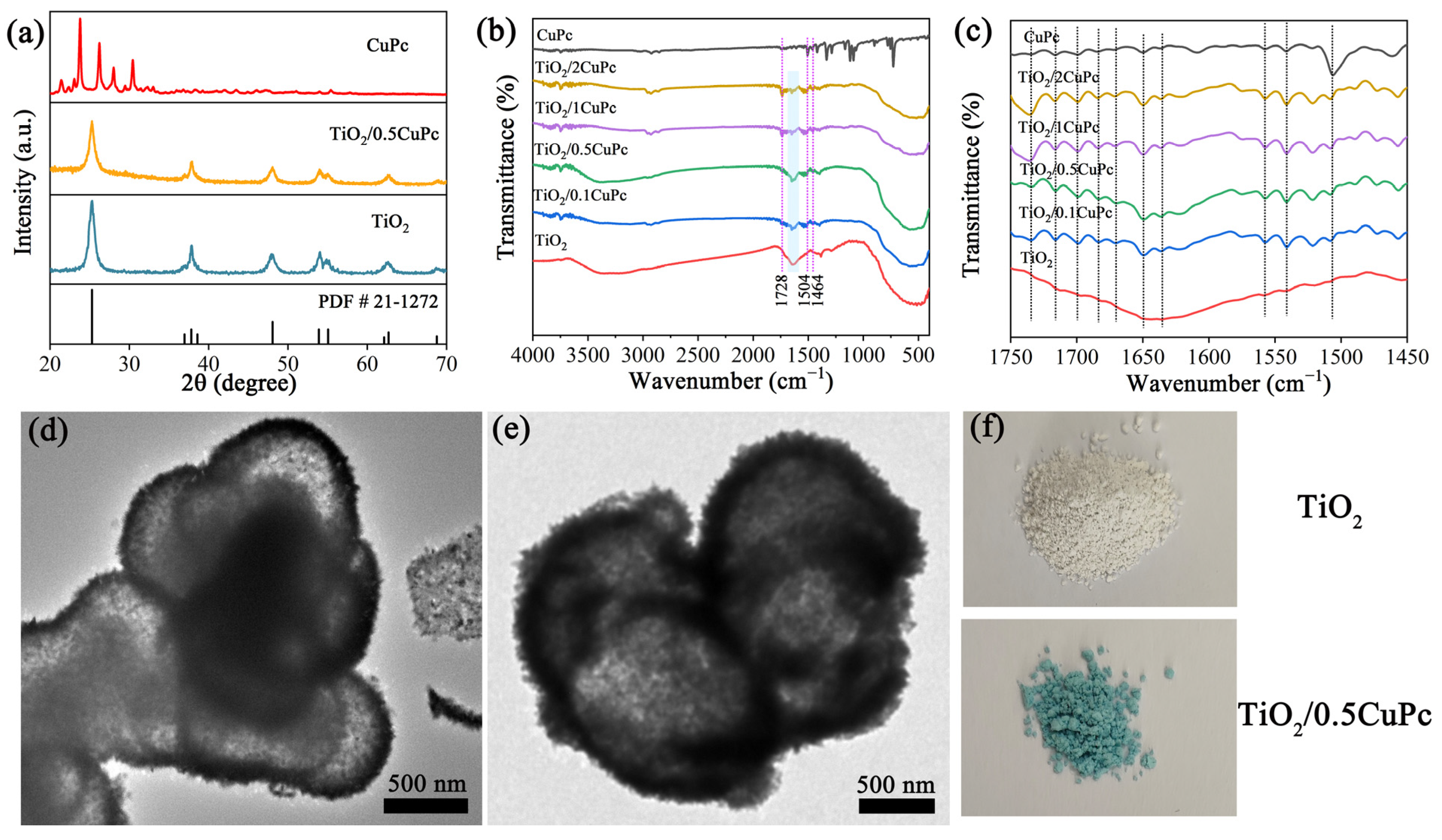
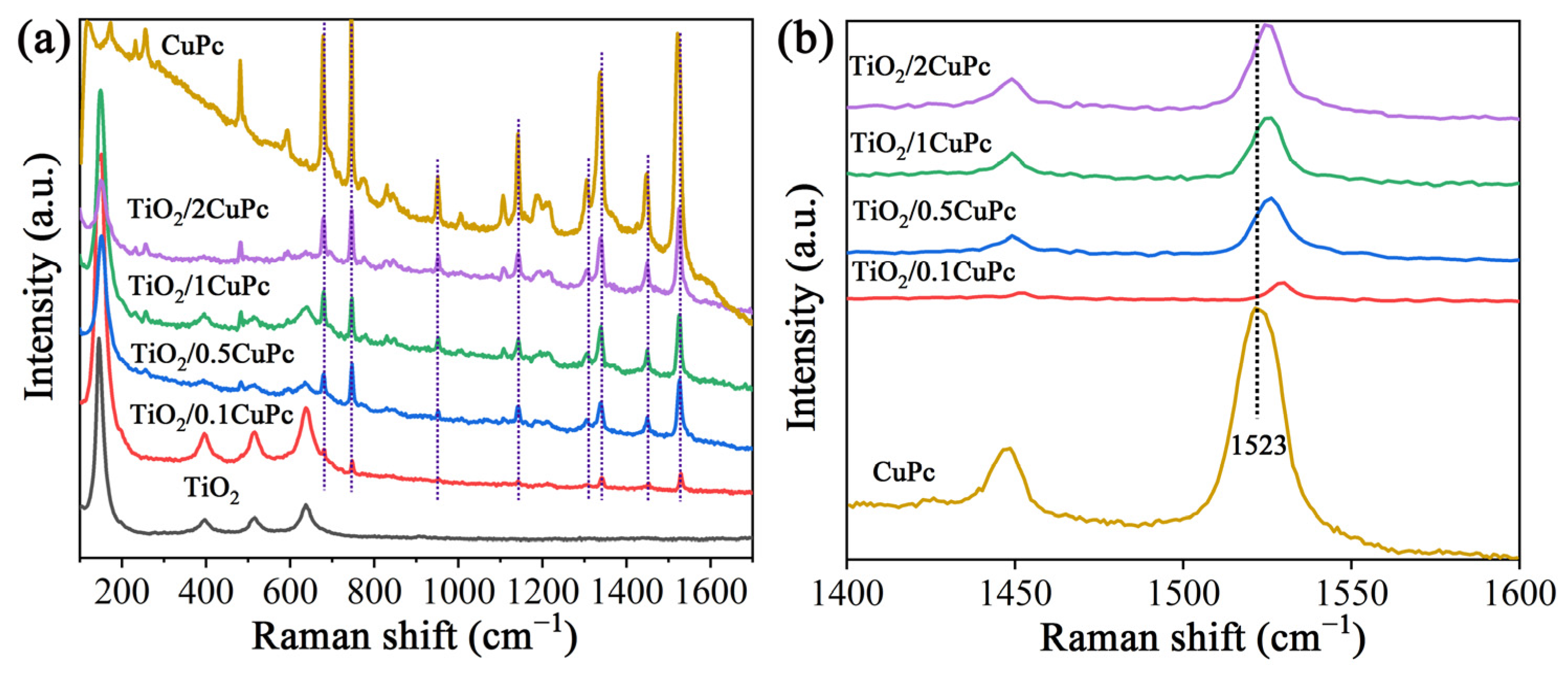
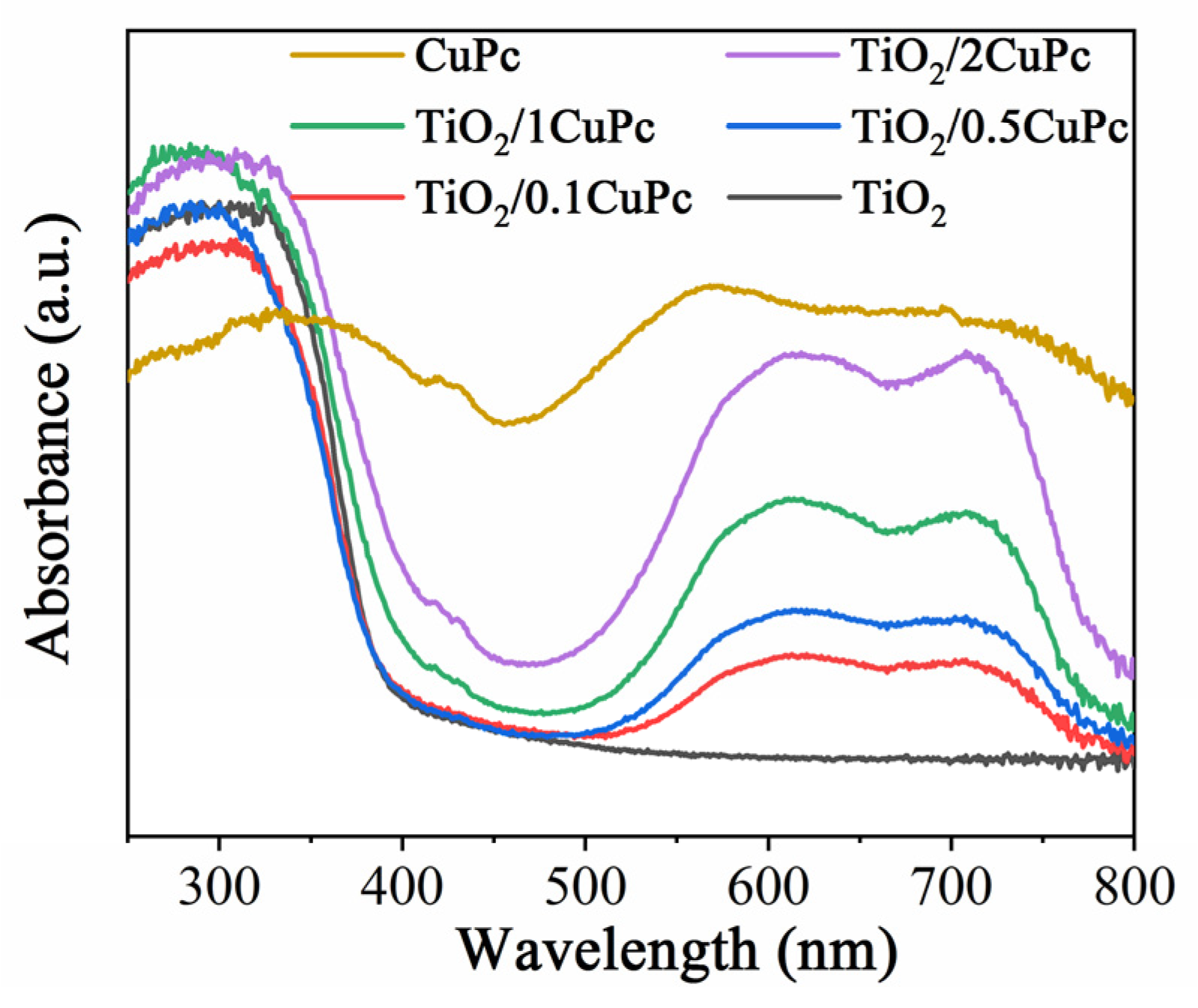
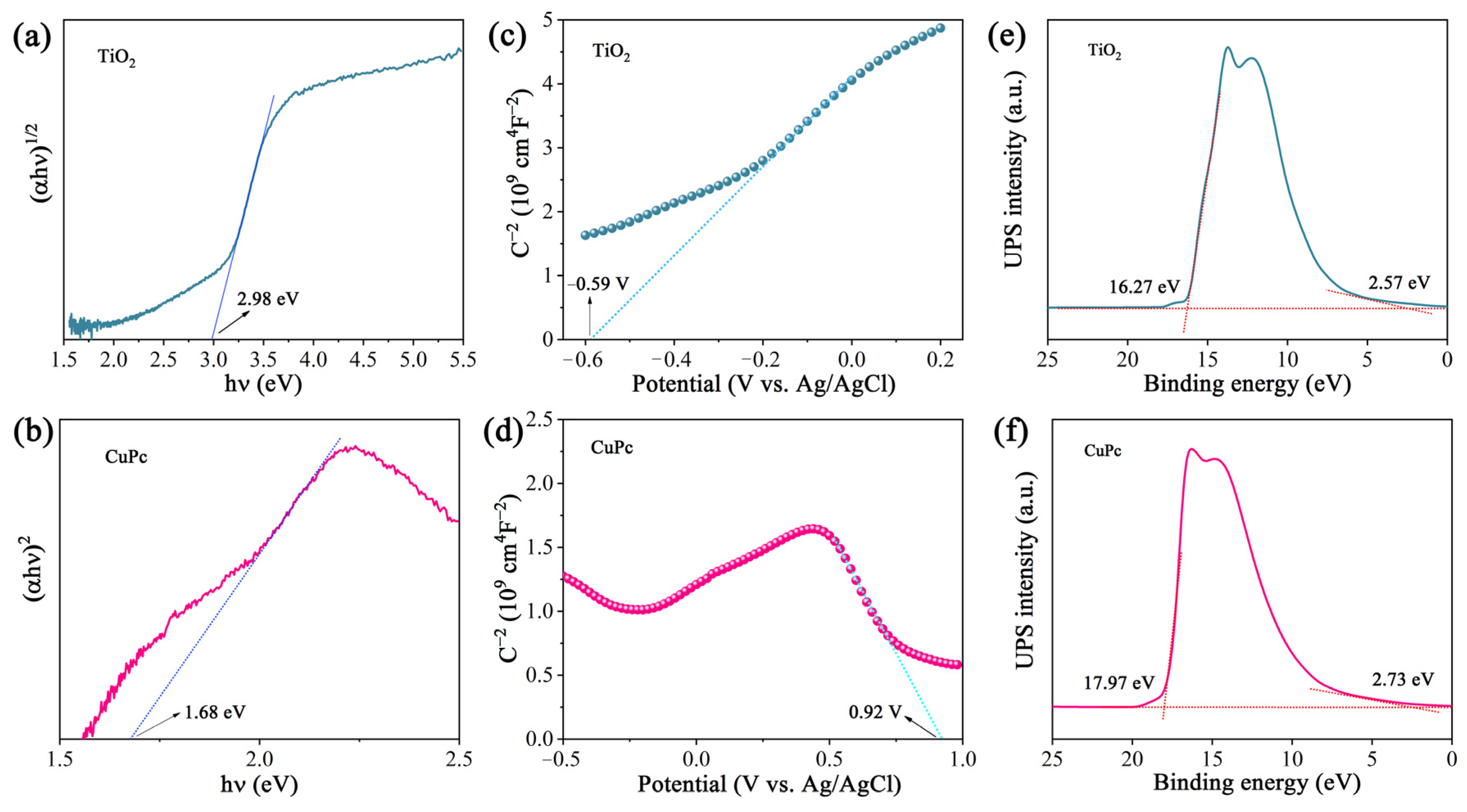
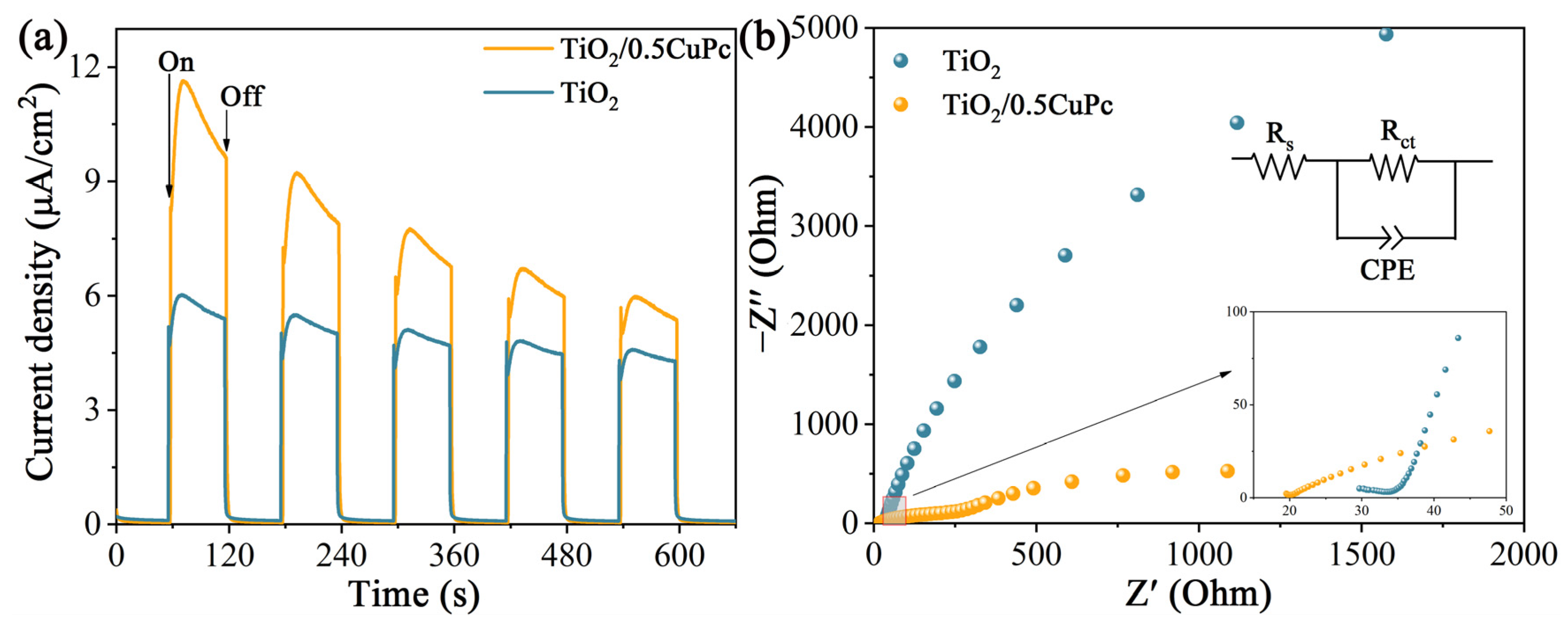
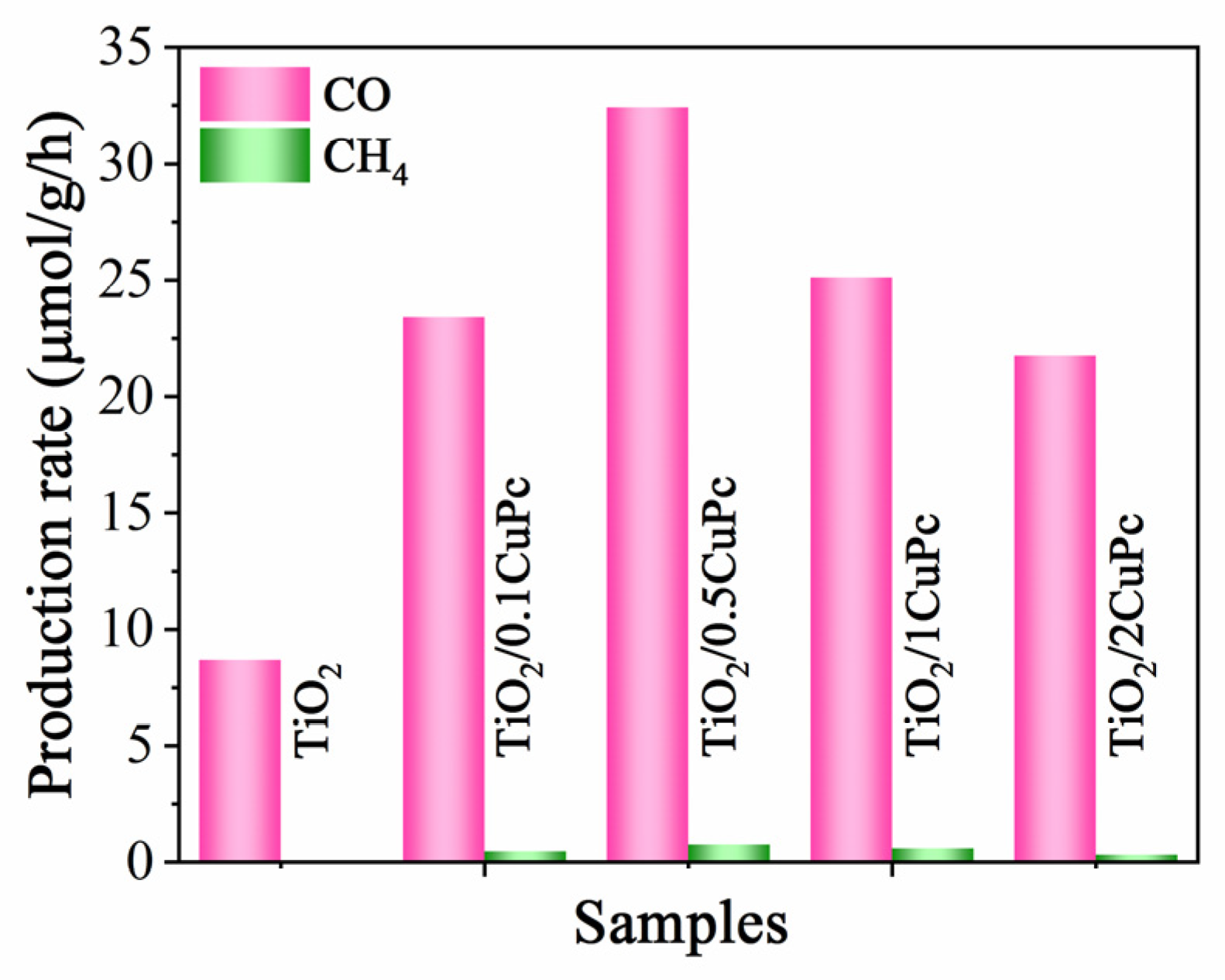
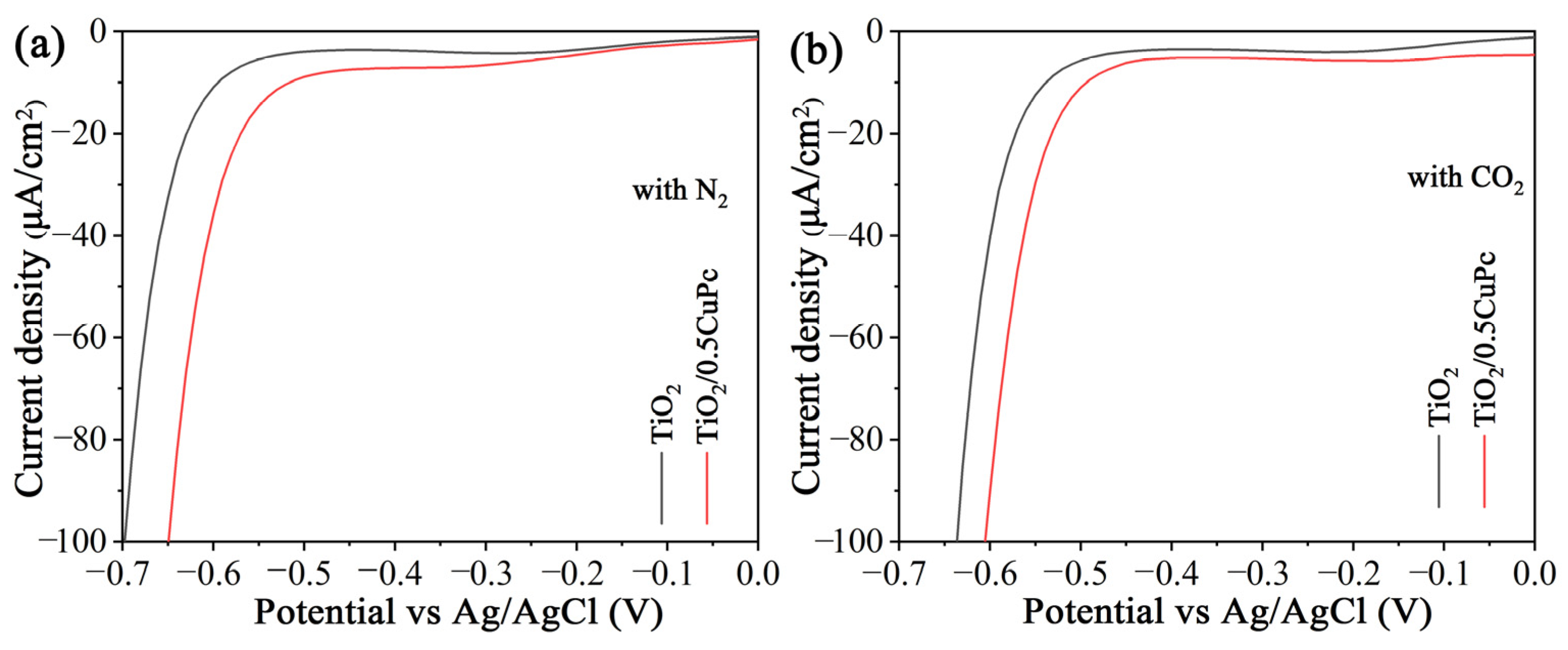
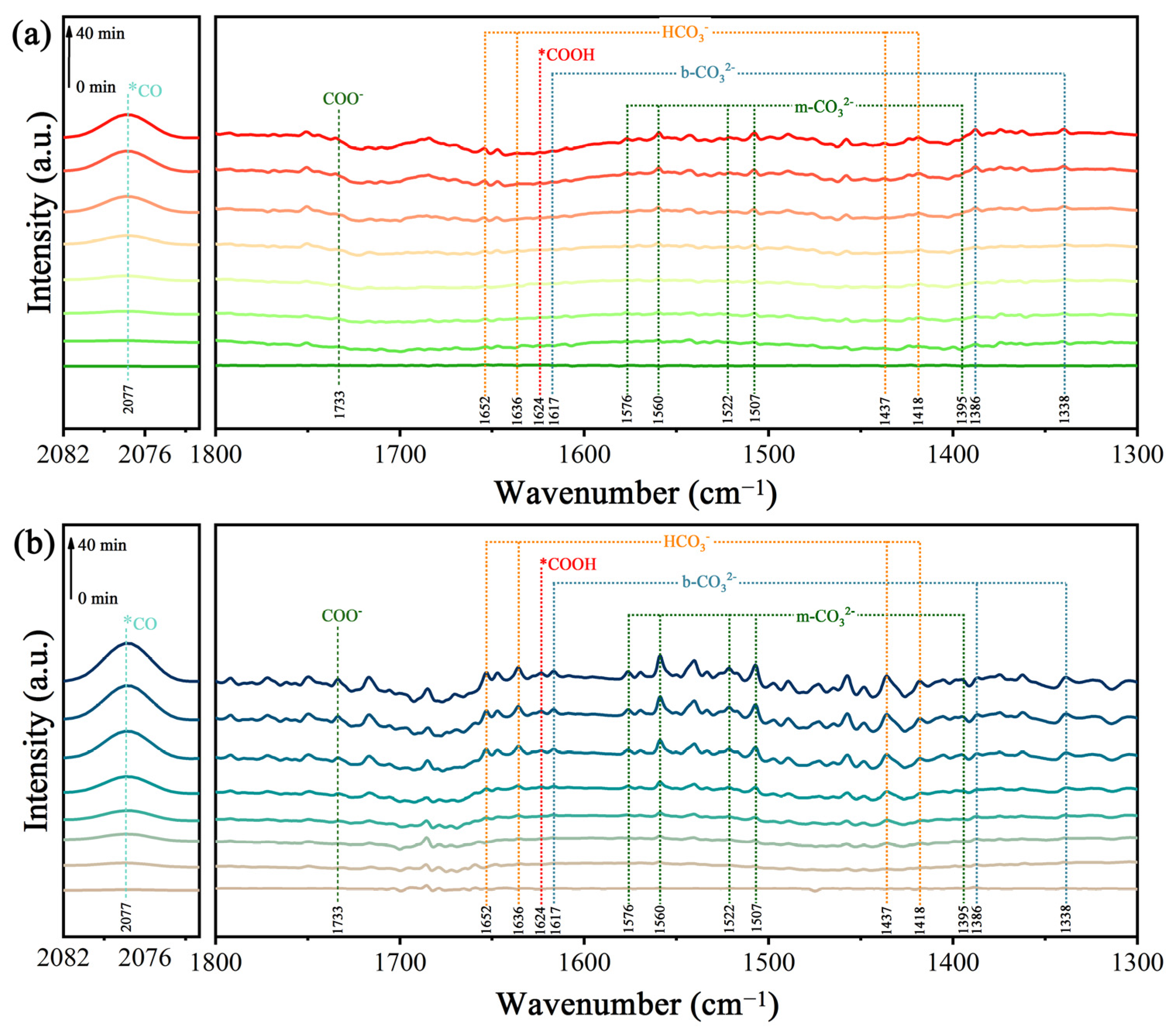

Disclaimer/Publisher’s Note: The statements, opinions and data contained in all publications are solely those of the individual author(s) and contributor(s) and not of MDPI and/or the editor(s). MDPI and/or the editor(s) disclaim responsibility for any injury to people or property resulting from any ideas, methods, instructions or products referred to in the content. |
© 2024 by the authors. Licensee MDPI, Basel, Switzerland. This article is an open access article distributed under the terms and conditions of the Creative Commons Attribution (CC BY) license (https://creativecommons.org/licenses/by/4.0/).
Share and Cite
Wang, J.; Fu, S.; Hou, P.; Liu, J.; Li, C.; Zhang, H.; Wang, G. Construction of TiO2/CuPc Heterojunctions for the Efficient Photocatalytic Reduction of CO2 with Water. Molecules 2024, 29, 1899. https://doi.org/10.3390/molecules29081899
Wang J, Fu S, Hou P, Liu J, Li C, Zhang H, Wang G. Construction of TiO2/CuPc Heterojunctions for the Efficient Photocatalytic Reduction of CO2 with Water. Molecules. 2024; 29(8):1899. https://doi.org/10.3390/molecules29081899
Chicago/Turabian StyleWang, Jun, Shuang Fu, Peng Hou, Jun Liu, Chao Li, Hongguang Zhang, and Guowei Wang. 2024. "Construction of TiO2/CuPc Heterojunctions for the Efficient Photocatalytic Reduction of CO2 with Water" Molecules 29, no. 8: 1899. https://doi.org/10.3390/molecules29081899
APA StyleWang, J., Fu, S., Hou, P., Liu, J., Li, C., Zhang, H., & Wang, G. (2024). Construction of TiO2/CuPc Heterojunctions for the Efficient Photocatalytic Reduction of CO2 with Water. Molecules, 29(8), 1899. https://doi.org/10.3390/molecules29081899




